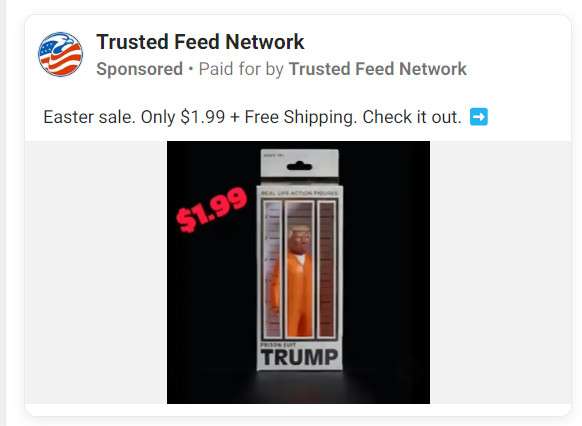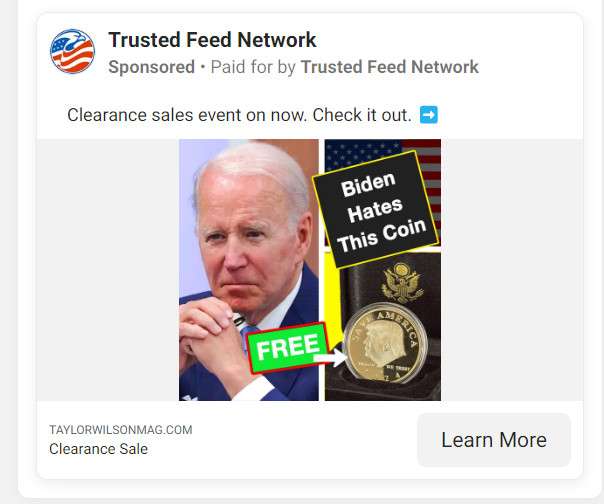A viral Facebook ad promotion claiming to offer commemorative Trump coins and patriotic merchandise for just $1.99 seems too good to be true. And tragically, it is. This widely circulated post hides a devious fake order page tricking users into signing up for expensive recurring credit card charges. In this exposé, we unravel the clever deception and hidden fees of the President Trump Easter Bundle subscription scam. By fraudulently exploiting Trump’s brand, this shady offer has extracted untold sums from misled victims. Learn how to avoid being duped by recognizing the convincing phishing techniques designed to harvest your payment information and saddle you with exorbitant hidden costs exceeding $100 per month. The shocking catch behind this holiday season social media scam reveals why such unbelievable deals require your greatest skepticism.


Scam Overview
A prolific online scam promotion promising commemorative President Trump coins and patriotic merchandise for just $1.99 shipping has aggressively circulated on social media platforms including Facebook, Instagram and YouTube. This remarkably deceptive viral marketing campaign ensnares victims by exploiting Trump and MAGA branding to falsely convey special clearance pricing and exclusivity.

In reality, these promotions are entirely fraudulent, originating not from Donald Trump or his campaign but from malicious scammers seeking to phish for users’ sensitive personal and financial data. By directing social media users through a series of slick phishing websites disguised as official Trump store domains, the scammers aim to harvest credit card information. This results in unauthorized recurring subscription fees billed to victims amounting to as much as $2000 yearly.
The cornerstone of the ruse involves touting the patriotic-themed merchandise as an “$89.95 value” bundle attainable for a mere $1.99 shipping fee. This false impression of scoring big savings on exclusive Trump goods primes victims to willingly input their payment info. However, no products actually ship out, and the $1.99 is simply to capture billing data.
Some examples of the deceitful techniques used in the President Trump Easter Bundle subscription scam include:
- Prominent use of Trump’s image, name and MAGA logos without consent, falsely implying association
- Similarly unauthorized use of The White House imagery and presidential seals to appear official
- Fake limited-time urgency with countdowns and claims of restricted Easter-only availability
- Too good to be true pricing like an $89 bundle for just $1.99 that defies credibility
- Burying subscription disclaimers and recurring billing terms in tiny, dark gray text rarely clicked on
- Pre-checking boxes that terms were read and agreed to in order to charge users unaware
- Padlock icons and Norton seals copied from security sites to help phishing pages seem legitimate
- Rigged order forms and payment pages made to appear as secure Trump store checkout
- Checkout steps designed to make users feel obligated to complete the purchase after inputting info
- Lack of verified contact information or cancellation options once fraudulent charges begin
The reality is no legitimate retailer would ever require personal financial information just for inexpensive shipping on promotional merchandise. And no authorized Trump store would hide astronomical unexpected fees. By recognizing these and other red flags, social media users can avoid taking the bait of even compelling viral scams like the President Trump Easter Bundle subscription trap. Caution and vigilance is key to protecting payment data and avoiding recurring hidden charges from shady imposter vendors.
This scam has been also investigated by Jordan Liles on his YouTube channel, where he offers a detailed video on the subject. We recommend watching his content for a comprehensive understanding of the scam.
Next, let’s break down exactly how scammers carry out this scam from start to finish.
How the President Trump Easter Bundle Scam Works
This insidious phishing scheme to snare victims through viral Facebook ads for Trump goods relies on sophisticated techniques. By guiding users through a sequence of deceitful pages and psychological tricks, the scammers behind the President Trump Easter Bundle scam often succeed in securing users’ financial data and signing them up for costly hidden subscriptions.
Here is an in-depth walkthrough of how this scam works to exploit Trump supporters’ affinity and short-circuit their skepticism:
1. Misleading Social Media Ads
- Ads promoting the Trump Easter Bundle appear in Facebook feeds, Instagram Stories or YouTube alongside legitimate content.
- The ads integrate official Trump and presidential images without consent to appear bona fide.
- Terms like “Clearance Sale” and “Massive Discount” convey the false impression of an authorized promotion.
- Countdown timers, purchase counters and claims of expiring Easter availability add fabricated urgency.
2. Phony Product Landing Pages
- Clicking these ads leads to phishing sites like taylorwilsonmag.com set up weeks prior.
- These showcase Trump Easter Bundle details with more pirated Trump assets used without permission.
- $89.95 value hype and $1.99 price claims leverage consumers’ tendency to overvalue bundled savings.
- Fake 5-star reviews, seals and secure checkout imagery build illegitimate trust and credibility.
3. Duping Users to Input Payment Info
- Users are led through polished checkouts mimicking legitimate e-commerce flows.
- Order forms request just enough PI including name, address and payment card data to process subscriptions.
- Pre-checked form disclosures give the false impression terms were rigorously reviewed by the scammers’ lawyers.
- No merchandise actually ships, but this fact is obscured to secure users’ billing data.
4. Charging Exorbitant Hidden Fees
- After users submit payment info expecting a single small $1.99 charge, the fraud begins.
- Monthly recurring subscription fees from $50 – $150 are charged to the cards on file without consent.
- Tiny print terms disclosing these illegal auto-billings are typically overlooked when purchasing.
- Unwanted fees persist and add up until victims undertake an arduous cancellation process.
5. Difficulty Canceling and Recovering Losses
- Phone numbers provided route to voicemail with no actual customer support provided.
- Email contacts are fake or never replied to, making it exceedingly difficult to halt charges.
- Cardinal rule violations leave credit card companies unwilling to issue refunds.
- Cancelling entire cards becomes only recourse but allows scammers to keep ill-gotten payments.
- Reputable trust seals used without permission further complicate matters for reporting agencies.
By comprehending the intricate web of deception spun to perpetrate this egregious scam, consumers can recognize the manipulative tricks used to lower skepticism. With heightened scrutiny of unbelievable deals, verification of legitimacy, and actually reading fine print, we can shield our wallets and data from these frauds seeking to hijack the Trump name, however well-crafted their viral scam funnel.
What to Do if You Fell Victim to the President Trump Easter Bundle Scam
If you unfortunately already submitted payment information through one of the President Trump Easter Bundle scam websites, here are some important steps to take right away:
- Contact your credit card provider immediately to report the charges as fraudulent. Request that all future charges from the vendor be blocked.
- Monitor your statements vigilantly over the next weeks for any recurring subscription fees and dispute them.
- Check your card statements and accounts for any other suspicious or unrecognized charges from around the same time.
- Call the scam vendor at the phone number provided in their terms and conditions to demand cancellation of all billing.
- If cancellation or refunds are not provided, follow up with your card issuer to reiterate the transactions are fraudulent.
- Consider proactively cancelling your credit card to prevent future hidden charges if vendors are uncooperative.
- If funds were paid via PayPal, report the seller there to halt payments and recover losses through PayPal buyer protection.
- Contact TRUSTe, Norton and other groups if their trust seals were misused on the phishing sites to aid removal.
- File complaints with the FTC and Internet Crime Complaint Center documenting all fraudulent activities and losses.
- Spread warnings about this Trump Easter Bundle scam on social media to prevent further victims being deceived.
Frequently Asked Questions About the Deceptive Trump Easter Bundle Subscription Scam
1. What exactly is the Trump Easter Bundle scam?
The Trump Easter Bundle scam is a deceptive viral marketing campaign that uses fake social media ads and phishing websites to trick users into signing up for expensive recurring credit card charges disguised as a one-time purchase for patriotic Trump merchandise.
2. How does the Trump Easter Bundle scam work?
Scammers run Facebook ads and web pages promoting a supposed $89 value bundle of Trump coins and merch for just $1.99 shipping. Users are directed to polished checkout flows that capture credit card information under the guise of covering shipping fees. Then monthly subscriptions from $50-$150 are charged without consent, saddling victims with huge unexpected fees.
3. What are some red flags of the Trump Easter Bundle scam?
Red flags include unbelievable prices like $89 bundles for $1.99, fake scarcity claims, unauthorized use of Trump’s image, missing contact information, pre-checked forms, recently created domains, and tiny print terms disclosing recurring fees.
4. Are the Trump Easter Bundle ads associated with Donald Trump?
No. Scammers are illegally using Trump’s name, images, and branding without permission to execute this fraud. The ads and websites originate from malicious actors unaffiliated with Trump or his organizations.
5. Where do I report the Trump Easter Bundle scam?
Report illegitimate charges to your credit card provider and file complaints with the FTC, IC3.gov and social media platforms where the ads appeared. You can also contact scam reporting agencies if their logos were misused like Norton or TRUSTe.
6. What should I do if I fell for the Trump Easter Bundle scam?
Immediately contact your credit card company and report all charges related to the scam as fraudulent. Ask them to block the vendor from future billing. Monitor statements closely for recurrence of the unwanted subscriptions and dispute them.
7. How can I get my money back after being scammed?
Unfortunately obtaining refunds is difficult since you technically provided your card details willingly, even if deceived. Threaten to cancel your card if the vendor refuses to refund unauthorized recurring fees. If payments were through PayPal, report the seller there for scamming.
8. How can I cancel and stop recurring credit card charges?
Call the number provided by the scammers in any terms or conditions and firmly demand cancellation of all billing. However, this likely will not work. More effectively, proactively cancel the credit card used entirely to prevent future hidden charges.
9. Could I actually receive any merchandise from the Trump Easter Bundle scam?
It is highly unlikely you will receive any coins, apparel or merchandise actually promoted in the scam. The ads and website are a pure pretext to obtain billing information and enroll victims in recurring credit charges. No physical products are typically delivered.
10. How can I avoid falling for similar subscription scams in the future?
Be wary of too good to be true prices or exaggerated savings claims. Read all terms thoroughly before submitting payment data. Beware newly created domains, missing contact info, or pre-checked forms. Always verify a seller is legitimate before providing financial information.
The Bottom Line
The President Trump Easter Bundle scam preys on patriotic sentiments and affinity for the Trump brand to trick users into giving up payment information. By advertising non-existent clearance deals on commemorative merchandise using Donald Trump’s unauthorized likeness, this fraudulent scheme has siphoned untold sums through hidden recurring subscription fees.
Avoiding becoming a victim requires carefully scrutinizing too good to be true offers, especially any requesting sensitive user data. As scammers become more technologically sophisticated, even savvy social media users must stay vigilant against phishing attempts to safeguard their financial information. Heeding warning signs like newly registered domains, missing contact details and pre-checked forms can protect against deceptive viral promotions like this Trump-themed bundle scam.










